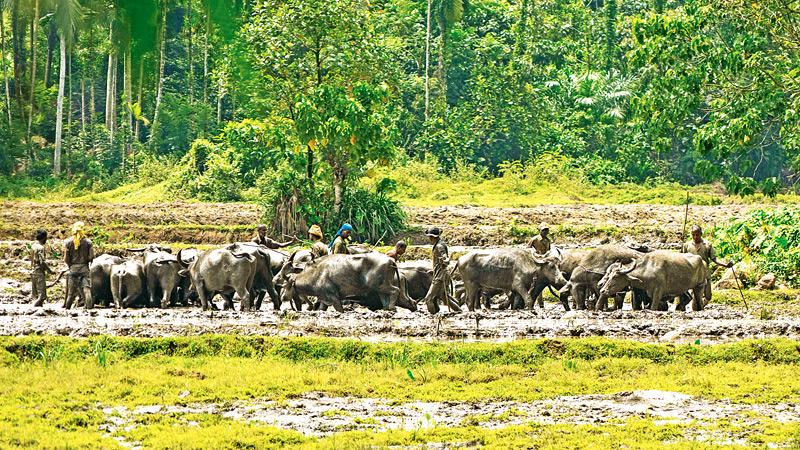
Across the country, paddy fields get a fresh leaseof life these days. If you travel around the countryside, you may come across paddy farmers - Goviya – who work in paddy fields in the Yala season, reconstructing the ‘Niyara’ with mammoties and ploughing the field traditionally with water buffaloes or now, with tractors in the paddy fields under the harsh morning sun. This is a fascinating sight.
 Paddy cultivation has taken root, transforming into the lifeblood of the islanders and setting the pace for a national culture embellished with elaborate rituals centered around the preparation of the fields for sowing paddy.
Paddy cultivation has taken root, transforming into the lifeblood of the islanders and setting the pace for a national culture embellished with elaborate rituals centered around the preparation of the fields for sowing paddy.
Sri Lanka’s legendary harvests once brought it fame as the Granary of the East. Historical records tell us that paddy cultivation in Sri Lanka dates back thousands of years, giving not only sheer physical sustenance to the nation but also a sacred culture based on agriculture.
Today, it is cultivated across the island. As society evolved, paddy cultivation rose to prominence.
To witness the traditional ploughing in the paddy field, I walked into a village that lives by the traditions and way of life passed down for hundreds of years. A little distance away from Ratnapura, lies an endearing little village called Amuthagoda. Unspoilt and remote, Amuthagoda is host to a charmed way of life and age-old traditions unheard of in modern Sri Lanka. Amidst the natural beauty, the village is interspersed with farming lands and paddy fields,the traditional farming methods of which I captured in my camera lens.
The traditional agriculture calendar in Sri Lanka has two seasons, both linked to the monsoons. The ‘Yala’ season lasts from May to September, the duration of the southwest monsoon, and the ‘Maha’ season of October to March/April corresponds to the northeast monsoon.
These are so ingrained in our psyche that even city folk use the expression “Yalata Mahata” to talk of someone who comes on and off.
 Paddy cultivation is a communal collaboration involving both, land-owning farmers and tenant farmers or Anda Goviyas, who work individually and collectively, from the seeding.
Paddy cultivation is a communal collaboration involving both, land-owning farmers and tenant farmers or Anda Goviyas, who work individually and collectively, from the seeding.
Rice (Oryza sativa) is a true creature of the tropics. It likes its feet to stand in water for most of its growing season, which for the natural varieties is around 12 weeks, while basking in the bright sun. Even with Sri Lanka’s two rain-laden monsoons, this means rice needs irrigation – reservoirs to collect and store water, and an intricate, gradient-based network of channels, to distribute it to the fields. Sri Lanka has a remarkable irrigation system – a true marvel of the ancient world.
Rice needs a deeply dug, squelchy bed of mud in which to germinate, so that ploughing is an important stage of its cultivation cycle. The field is first submerged in water through feeder channels to soften the sunbaked earth and rot the stubble of the last harvest, a process which also enriches the soil. The initial stage of rice growing, ploughing is done with much ceremony, driving the team of water buffaloes yoked to a wooden plough which they drag across the flooded field, churning the mud and turning the sod over. Traditionally, the ploughing was done as a ceremonial event in the past. The king, prince or chieftain officiated at this ceremony, called the Wap Magula, driving the team of water buffaloes yoked to a wooden plough. This is sometimes still enacted with the participation of the President or the Prime Minister.
At midday, after the beasts are unyoked, the farmers sit down to a hearty picnic lunch under the shade of trees. This meal, called the Ambula, consists of country (red) rice, a savoury dried-fish dish and some vegetable curry. Hard work, fresh air and home-cooked flavours make the Ambula a much-relished meal. There is even a song that celebrates this ritual – Mohideen Baig’s “Tikiri Menike Ambula Genalla” (Tikiri Menike has brought the Ambula) which conjures up an image of village damsels bringing lunch on lotus leaves to the farmers.
Along with the ploughing, the un-hulled rice (or seed paddy) is made ready for sowing, soaked in jute bags for a day, after which the grain begins to sprout.
The field, which is now a soft, swampy mire, is further nursed into an absolutely flat and smooth condition with thin, long-handled wooden planks, and painstakingly parcelled out into a series of ridges and dropped beds so that water will stand at the roots of the growing rice. The sloping ground is laboriously manicured into tiers of flat terraces.
The sowing of seed is preceded by a simple folk ritual in which the gods are offered the first handful, along with palm candy (jaggery) and grated coconut.
This offering represents the sower’s pledge of more alms to come. This process is usually done by the experienced chief farmer who owns the paddy field.
Sowing is no mean task as the sprouting seed has to be sprinkled thinly and evenly, so that the rice will be evenly laid in the field and not in clumps and bare patches. Unfortunately, years of colonization brought an end to those days of plenty. Despite the spread of modern farming technology, some ancient practices continue in the rural countryside.
Sadly, these green practices are giving way to new industrial farming technology like the use of chemical pesticides.
The traditional Sri Lankan paddy fields offer answers to the sustainability questions of today.
Paddy cultivation is extremely hard work for man and beast, with both wading knee-deep in mud. This toil is glorified in Sri Lanka’s ancient chronicles. “Wash off the mud from any farmer,” they proclaim, “and he is fit to be king.”
